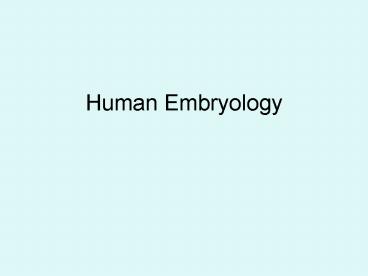Human Embryology - PowerPoint PPT Presentation
1 / 23
Title: Human Embryology
1
Human Embryology
2
Fertilization
- Fertilization- results in a zygote
- -requires the sperm egg nucleus to fuse
3
Sperm Structure
- Sperm- made of 3 parts
- head- contains haploid nucleus acrosome
- (enzymes that allow sperm to penetrate the
egg) - middle piece- contains mitochondria (make energy
ATP) - tail- flagellum- allows sperm to swim toward the
- egg
4
Egg Structure
- Egg structure contains 3 parts
- -plasma membrane, vitelline envelope, jelly coat
5
Fusion of egg and sperm
6
Female Reproductive System
7
Fertilization Process
- Acrosome enzymes of sperm digest away the jelly
coat - Acrosome extends a filament that attaches to a
receptor on vitelline envelope (like a lock
key) - Nuclear membrane of sperm plasma membrane of
egg fuse
8
Fertilization Process (cont.)
- Sperm nucleus enters the egg
- Zygote forms when sperm nucleus egg nucleus
fuse - Following fusion, the egg plasma membrane
vitelline envelope undergo changes that prevent
the entrance of other sperm - Vitelline envelope becomes the fertilization
envelope
9
Fertilization Process
- After egg is released from the ovary it moves
into the fallopian tube and waits for the arrival
of the sperm and fertilization to take place - Then wave-like action of cilia move the
fertilized egg toward the uterus for implantation
to take place
10
(No Transcript)
11
Fertilization of female egg
12
- Development- all the changes that occur during
the life of an organism - Embryo- 1st stages of development of an organism
after the zygote forms
13
Cell Division12 buckle my shoe
- Embryonic Development (Continued)
- -zygote undergoes cleavage (cell division w/o
growth)- mitosis and DNA replication occur
repeatedly - Once the zygote is formed it begins to divide
through a process called cleavage. - Upon completion of the first division, you have
two cells. Then these two cells divide to form
four cells.
14
(No Transcript)
15
Deuterostomes vs. ProtostomesSAY WHAT???
- 8-CELL STAGE IS KEY DIFFERENCE!!!-Deuterostomes-
(starfish vertebrates) cleavage results in 8
cells sitting directly on top of each other.
This is called radial cleavage
16
Protostomes
- protostomes (clams, worms, insects) undergo
spiral cleavage- cells divide and they do not sit
on top of each other they appear to spiral
17
Morula
- The eight cells now continue to divide until you
are simply a large solid ball of cells (16-32
cells).
Morula
18
Blastula
- At this time, the morula begins to form a hollow
ball of cells called the blastula. - The blastula contains a fluid filled space known
as the blastocoel.
19
(No Transcript)
20
Gastrula
- Now gastrulation occurs. The hollow ball of
cells known as the blastula begins to fold inward
on one side - (imagine that you had a deflated basketball and
pushed it in on one side). - When the folding occurs, it begins to create a
horse shoe shaped structure that is 2 cell layers
thick..
21
Gastrula (cont.)
- The outer layer of the ball is called the
ectoderm. The inner layer of the ball is called
the endoderm. - Eventually, another cell layer will begin to form
between the endoderm and ectoderm. This layer is
called the mesoderm. - The point where the horse shoe almost touches is
called the blastopore (small hole). - In protostomes this will eventually form the
mouth. - In deuterostomes this will form the anus.
22
3 tissue layers
- Ectoderm- forms nervous system outer
- layer of skin
- Mesoderm- forms muscle, bone,
- cardiovascular system
- Endoderm- organs of digestive system,
- lining of respiratory
system - bladder
23
What do the 3 layers become?






















![[PDF] Netter's Atlas of Human Embryology 1st Edition Kindle PowerPoint PPT Presentation](https://s3.amazonaws.com/images.powershow.com/10082437.th0.jpg?_=202407201010)



![[PDF] The Developing Human 10th Edition Android PowerPoint PPT Presentation](https://s3.amazonaws.com/images.powershow.com/10106001.th0.jpg?_=20240823069)

![[PDF] DOWNLOAD EBOOK Human Embryology and Developmental Biology PowerPoint PPT Presentation](https://s3.amazonaws.com/images.powershow.com/10130801.th0.jpg?_=20240916076)
![[PDF] DOWNLOAD FREE Human Embryology and Developmental Biology - Inkli PowerPoint PPT Presentation](https://s3.amazonaws.com/images.powershow.com/10130802.th0.jpg?_=20240916075)

